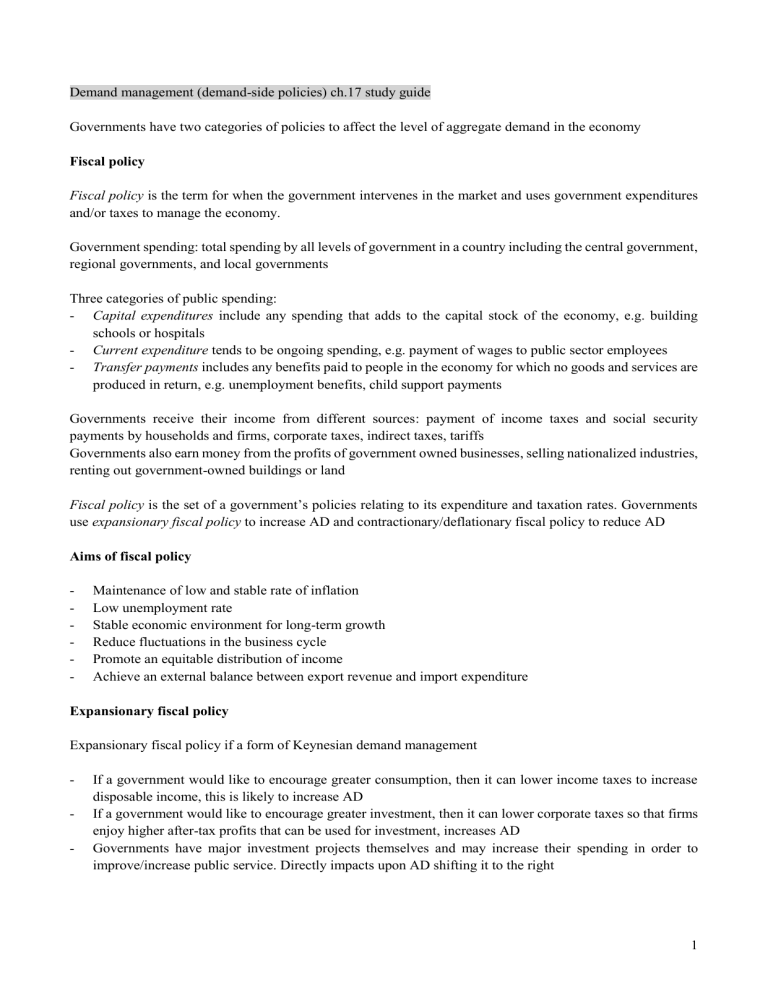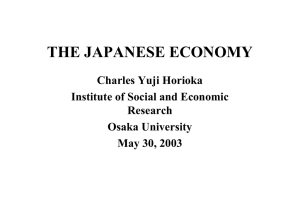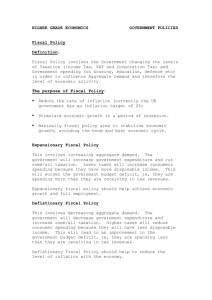Demand Management Study Guide: Fiscal & Monetary Policy
advertisement

Demand management (demand-side policies) ch.17 study guide Governments have two categories of policies to affect the level of aggregate demand in the economy Fiscal policy Fiscal policy is the term for when the government intervenes in the market and uses government expenditures and/or taxes to manage the economy. Government spending: total spending by all levels of government in a country including the central government, regional governments, and local governments Three categories of public spending: - Capital expenditures include any spending that adds to the capital stock of the economy, e.g. building schools or hospitals - Current expenditure tends to be ongoing spending, e.g. payment of wages to public sector employees - Transfer payments includes any benefits paid to people in the economy for which no goods and services are produced in return, e.g. unemployment benefits, child support payments Governments receive their income from different sources: payment of income taxes and social security payments by households and firms, corporate taxes, indirect taxes, tariffs Governments also earn money from the profits of government owned businesses, selling nationalized industries, renting out government-owned buildings or land Fiscal policy is the set of a government’s policies relating to its expenditure and taxation rates. Governments use expansionary fiscal policy to increase AD and contractionary/deflationary fiscal policy to reduce AD Aims of fiscal policy - Maintenance of low and stable rate of inflation Low unemployment rate Stable economic environment for long-term growth Reduce fluctuations in the business cycle Promote an equitable distribution of income Achieve an external balance between export revenue and import expenditure Expansionary fiscal policy Expansionary fiscal policy if a form of Keynesian demand management - If a government would like to encourage greater consumption, then it can lower income taxes to increase disposable income, this is likely to increase AD If a government would like to encourage greater investment, then it can lower corporate taxes so that firms enjoy higher after-tax profits that can be used for investment, increases AD Governments have major investment projects themselves and may increase their spending in order to improve/increase public service. Directly impacts upon AD shifting it to the right 1 If the government follows a successful expansionary fiscal policy, then there will be a shift of aggregate demand from AD1 to AD2. There will be inflationary pressure as the average price level rises from P1 to P2. However, there will be an increase in real output from Y1 to Y2 which will mean an increase in national income, increase in economic growth, decrease in unemployment Expansionary fiscal policy involves a ‘trade-off’ between lower unemployment and higher inflation How effective are fiscal policies? - Fiscal policy is effective in the long run at dealing with a deep recession Government expenditure can be used to target specific sectors of the economy as well as increasing AD through government expenditure and tax cuts, the government can invest the funds in areas of the economy that they believe will benefit the most from the investment and give tax cuts to the people that they think need them the most Constraints: 1. Time lags: changing fiscal policy takes time, tax rates can’t be changed quickly. Once fiscal changes have been made it is likely that it will take time before AD begins to shift. It is possible that the economy may have already recovered by the time fiscal policy effect take place and so they become inflationary 2. Political pressure: government sending and taxation are often influence by political factors 3. Sustainable debt: governments may have to run budget deficits in order to fund expansionary fiscal policies, may accumulate into unsustainable national debt in the long run 4. Effect on net exports: expansionary fiscal policy may lead to an increase in interest rates which may lead to an increase in the exchange rate making exports less attractive and imports more attractive, fall in (X-M) 5. Crowding-out effect: if governments attempt to increase spending through increased borrowing, they then monopolize the funds available in the economy for borrowing. Firms may not have access to funds for investment, investment will fall. AD will not shift as much since the increase in government spending will be partially offset by a fall in investment. Increased demand for borrowing by the government will also increase the interest rate – contractionary monetary effects 6. Inability to achieve specific targets: difficult to finely adjust fiscal policy to achieve specific targets, difficult to predict the precise outcome 2 Sustainable level of government debt Government (national) debt is the accumulation of all the budget deficits over the years and represents the total amount of money the government owes Costs of high levels of government debt: In the short-term many stakeholders in the economy benefit from deficit spending by the government as it drives economic growth As the government debt increase, debt servicing costs increase, and the government will spend more of its budget on interest costs - May lead to crowding out of private investments As interest payments increase as a percentage of government budget expenditure this may have effects on other areas of spending To maintain same levels of benefits and services may require higher rates of taxation may lead to falling output and incomes since it’s a deflationary fiscal policy May decrease the ability of governments to respond to emergencies Monetary policy Monetary policy is defined as the set of policies governing the supply of money and the level of interest rates in an economy. Governments use expansionary monetary policy to increase AD and contractionary/deflationary monetary policy to reduce AD Interest rates as a tool of monetary policy refers to the base rate that is set by a country’s central bank The central bank is not a private profit-making bank, essentially the governments bank, and the ultimate authority in control of the money supply in an economy Changes in the central banks base rate impacts upon all borrowing and lending in the economy Aims of monetary policy - Maintenance of low and stable rate of inflation Low unemployment rate Stable economic environment for long-term growth Reduce fluctuations in the business cycle Achieve an external balance between ecport revenue and import expenditure Expansionary monetary policy Changes in the central banks base rate can affect the level of AD in the economy to increase AD the central bank might lower the base rate of interest reduces the cost of borrowing and can lead to increases in both consumption and investment 3 They could also increase the supply of money which would lower its price, i.e. lower the rate of interest This is known as expansionary or loose monetary policy If the government follows a successful expansionary monetary policy, there will be a shift of AD from AD1 to AD2 There will be inflationary pressure as the average price level rises from P1 to P2 However, there will be an increase in real output from Y1 to Y2, Increase in national income, etc. how effective are monetary policies? - Relatively quick to put into place No political intervention Absence of “crowding out” Ability to make small changes: monetary policy enables more fine-tuning of the economy Limitations: 1. Time lags: although quick to change monetary policies still take time to have an effect on the economy 2. Ineffectiveness when interest rates are low: expansionary monetary policy through cuts in the rate of interest cant be used for ever 3. Low consumer and business confidence Difference between nominal and real interest rates Nominal rate of interest is the rate of interest available in the market, not allowing for inflation If the rate of interest is adjusted for inflation, it’s called the real rate of interest Real rate of interest = nominal rate of interest – inflation rate 4







